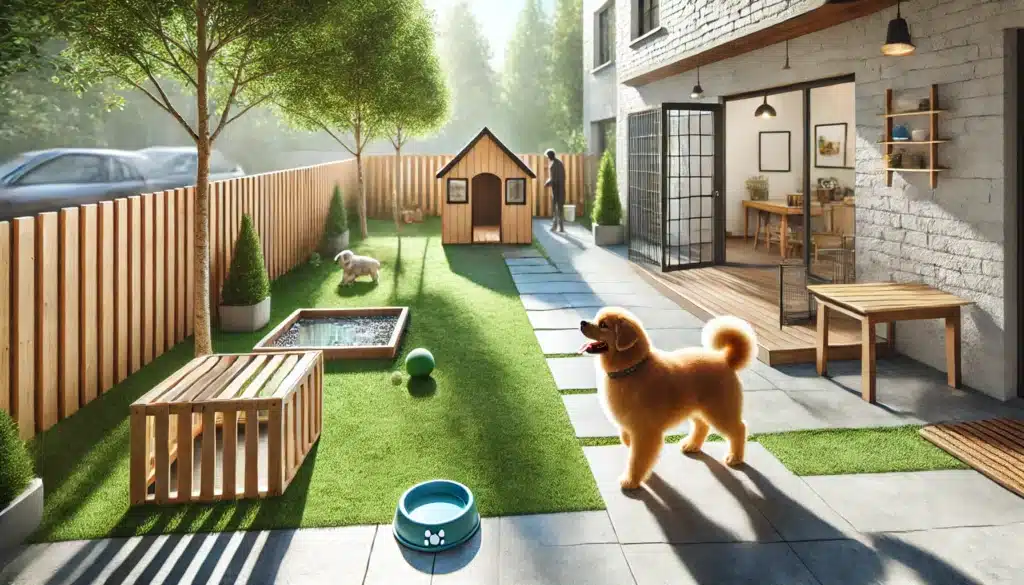Having a backyard or outdoor space can be a wonderful advantage for dog owners — offering more room for play, potty breaks, and relaxation. But just because your dog has access to a yard doesn’t mean they’re automatically getting all the care and stimulation they need.
In this article, you’ll learn how to make your yard safe, enriching, and dog-friendly, with practical tips for daily care, supervision, and maximizing the space for your dog’s health and happiness.
Why Outdoor Spaces Matter for Dogs
Outdoor areas provide dogs with:
- Fresh air and sunlight
- Room to run and explore
- A place to burn off energy
- Mental stimulation through smells and sounds
- An opportunity to express natural behaviors like digging, sniffing, or lounging
But to truly benefit your dog, your yard must be safe, clean, and structured.
1. Make Your Yard Secure
Your dog’s safety starts with proper containment.
🔒 Check your fencing:
- Is it tall enough? (At least 4–6 feet for most breeds)
- Are there gaps or holes your dog could squeeze through?
- Is the gate secure and always closed?
- For diggers: install chicken wire or pavers along the bottom edge
Tip: Never leave your dog outside unsupervised if your yard isn’t 100% secure.
2. Provide Shelter from the Elements
Dogs need protection from sun, rain, wind, and cold — especially if they spend long periods outdoors.
Set up:
- A dog house with insulation and shade
- Elevated beds to stay off hot or wet ground
- Access to shade trees or awnings
- Blankets or warm bedding in colder months
Never rely on a doghouse alone in extreme heat or cold — bring your dog indoors when conditions aren’t safe.
3. Always Offer Fresh Water
Outdoor dogs can get dehydrated quickly, especially in warm weather or during play.
- Use non-tip, shaded bowls or automatic waterers
- Refill and clean daily
- In winter, check for frozen water and consider heated bowls
- In summer, add ice cubes for extra cooling
Pro tip: Keep a second water station indoors as well.
4. Clean Up the Yard Regularly
A clean yard = a healthier dog.
- Pick up poop daily to prevent disease and flies
- Remove trash, sharp objects, or broken toys
- Cut the grass regularly to reduce ticks and fleas
- Avoid leaving out food, which can attract pests or wildlife
Keeping the yard tidy also reduces the chance of boredom-related digging or chewing.
5. Offer Mental and Physical Stimulation
A yard isn’t a substitute for walks, but it can be a great tool for enrichment.
Ideas:
- Hide treats around the yard for scent games
- Rotate outdoor toys for novelty
- Use a flirt pole or ball launcher
- Set up small agility equipment (like tunnels or jumps)
- Play hide-and-seek with your dog
- Use digging zones or sandboxes to allow natural digging behavior
Reminder: Dogs need human interaction to stay stimulated — not just access to space.
6. Protect Against Pests and Poisons
Outdoor dogs are exposed to more environmental risks — be proactive.
- Use flea, tick, and heartworm preventatives
- Avoid toxic plants (e.g., lilies, azaleas, sago palm)
- Don’t use chemical lawn treatments or fertilizers accessible to pets
- Keep compost, mulch, and trash sealed
- Monitor for wild animals or stray dogs
Tip: Ask your vet to help create a seasonal parasite prevention plan.
7. Supervise Outdoor Time (Especially for Puppies)
Even in a fenced yard, supervision is key — especially for young dogs or new rescues.
Watch for:
- Escaping behavior
- Digging under fences
- Eating grass, sticks, or non-food items
- Aggression toward other animals through the fence
- Signs of heatstroke or cold stress
As your dog learns the space, you can slowly increase unsupervised time (if the yard is secure).
8. Create a Comfortable Outdoor Routine
Dogs benefit from structure outdoors just like indoors.
Try scheduling:
- Morning potty break and sniff walk
- Midday play session
- Evening fetch or lounging time
- Short “check-ins” if your dog prefers to be outside for longer periods
Having a rhythm helps reduce barking, pacing, or digging caused by boredom.
9. Provide a Safe Potty Area
If your dog uses the yard for potty, set up a designated spot.
- Choose a low-traffic area
- Use pea gravel, mulch, or artificial turf for easy cleaning
- Pick up waste daily
- Reward your dog for going in the right spot
This keeps the yard cleaner and helps with consistent potty habits.
10. Don’t Replace Walks with Yard Time
It’s a common myth that a yard = no need for walks. In reality, walks are essential for:
- Bonding
- Training and structure
- Exposure to new environments
- Socialization
- Mental health
Aim for at least one walk a day in addition to yard time — even if it’s just 20 minutes.
Final Thoughts: A Yard Is a Privilege — and a Responsibility
Giving your dog access to a yard can enhance their life — but only if the space is safe, clean, and used intentionally. A neglected yard leads to boredom, stress, and even danger. But with a bit of planning and care, your outdoor area can become a doggy paradise where your pet can thrive.
And remember — the best part of the yard isn’t the space. It’s sharing it with you.







